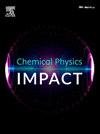揭示珊瑚叶提取物对超级电容器用CoWO4电化学性能的影响
IF 4.3
Q2 CHEMISTRY, PHYSICAL
引用次数: 0
摘要
对可持续、高性能储能材料的追求促使了对绿色合成策略的研究。本研究采用两种方法合成钨酸钴纳米颗粒(CoWO4 NPs):一种是利用珊瑚叶提取物(CoWO4- g)的绿色方法,另一种是传统的水热化学方法(CoWO4- h),比较它们的电化学性能。x射线衍射(XRD)分析证实了单斜CoWO4的形成,绿色法测得的晶粒尺寸为24.18 nm,化学法测得的晶粒尺寸为27.45 nm。FTIR分析证实了两种样品的相形成,FESEM图像显示了凝聚的球形形貌。利用HRTEM和粒度直方图验证了纳米尺度的尺寸,并证实了Debye-Scherrer和Williamson-Hall分析得出的晶体尺寸结果。BET表面积分析表明,CoWO4-G样品的表面积(77.3 m2/g)明显大于cowoo - h样品(49.6 m2/g),从而增强了电荷存储能力。元素映射验证了Co和w的一致分布。在3 M KOH中进行的电化学测量,包括循环伏安法(CV)、恒流充放电法(GCD)、电化学阻抗谱法(EIS)和Tafel极化,表明CoWO4-G具有增强的比电容、降低的电荷转移电阻和提高的循环稳定性,可达10,000次循环。这种增强是由于叶提取物中的植物化学物质对材料的表面性质和电子行为的影响。本研究强调了珊瑚藻辅助合成的可行性,作为一种可持续的方法来开发用于超级电容器应用的高性能电极材料。本文章由计算机程序翻译,如有差异,请以英文原文为准。

Unveiling the role of Corallocarpus epigeous leaf extract on electrochemical properties of CoWO4 for supercapacitor applications
The pursuit of sustainable, high-performance materials for energy storage has prompted investigations into green synthesis strategies. This study synthesised cobalt tungstate nanoparticles (CoWO4 NPs) using two methods: a green approach utilising Corallocarpus epigeous leaf extract (CoWO4-G) and a conventional hydrothermal chemical method (CoWO4-H) to compare their electrochemical performance. X-ray diffraction (XRD) analysis confirmed the formation of monoclinic CoWO4, with crystallite sizes measured at 24.18 nm for the green method and 27.45 nm for the chemical method. FTIR analysis confirmed the phase formation and FESEM images demonstrated agglomerated spherical morphologies in both samples. The use of HRTEM and particle size histograms validated nanoscale dimensions and corroborated the crystallite size results obtained from Debye-Scherrer and Williamson–Hall analyses. BET surface area analysis indicated a significantly greater surface area in the CoWO4-G sample (77.3 m2/g) relative to the CoWO-H sample (49.6 m2/g), thereby enhancing charge storage capabilities. Elemental mapping verified the consistent distribution of Co and W. Electrochemical measurements conducted in 3 M KOH, encompassing cyclic voltammetry (CV), galvanostatic charge-discharge (GCD), electrochemical impedance spectroscopy (EIS), and Tafel polarization, revealed that the CoWO4-G displays enhanced specific capacitance, reduced charge transfer resistance, and improved cycling stability up to 10,000 cycles. The enhancements result from the influence of phytochemicals in the leaf extract on the surface properties and electronic behaviour of the material. This research emphasizes the viability of Corallocarpus epigeous assisted synthesis as a sustainable approach for developing high-performance electrode materials intended for supercapacitor applications.
求助全文
通过发布文献求助,成功后即可免费获取论文全文。
去求助
来源期刊

Chemical Physics Impact
Materials Science-Materials Science (miscellaneous)
CiteScore
2.60
自引率
0.00%
发文量
65
审稿时长
46 days
 求助内容:
求助内容: 应助结果提醒方式:
应助结果提醒方式:


